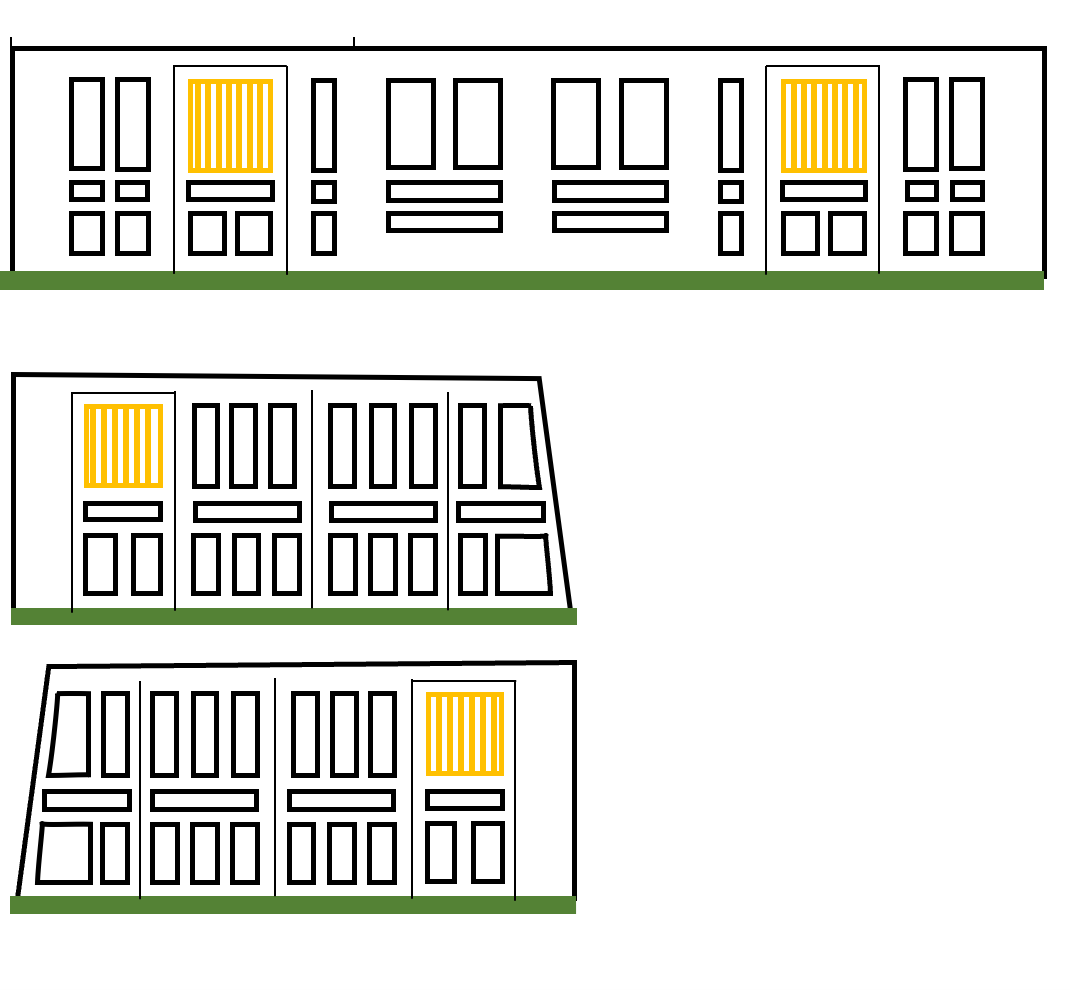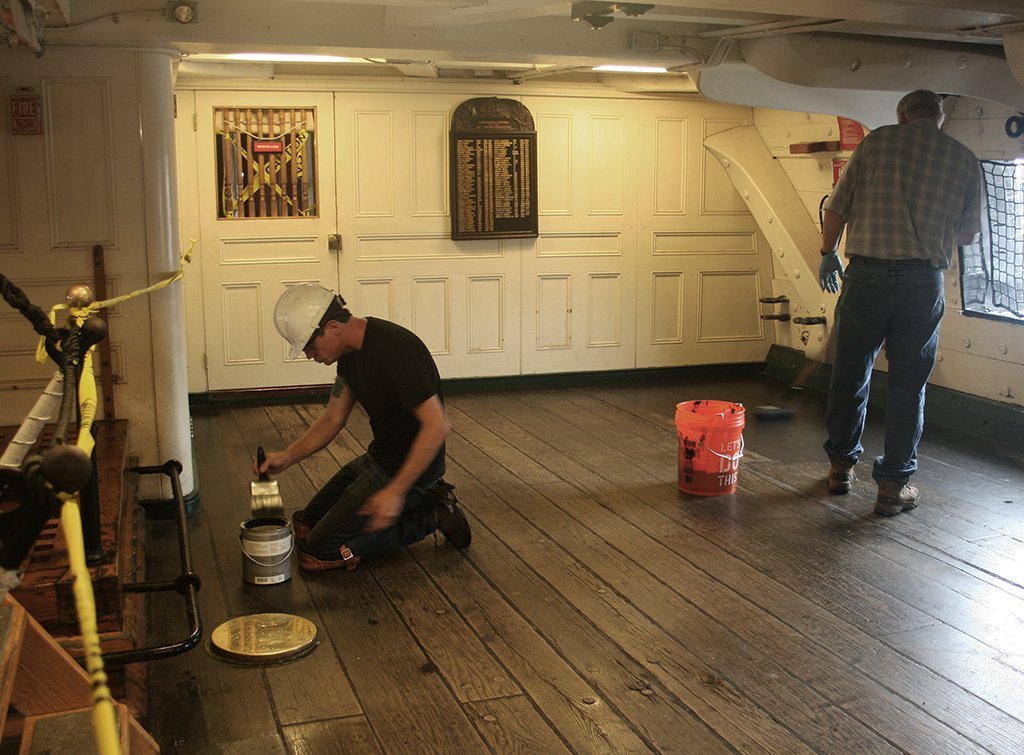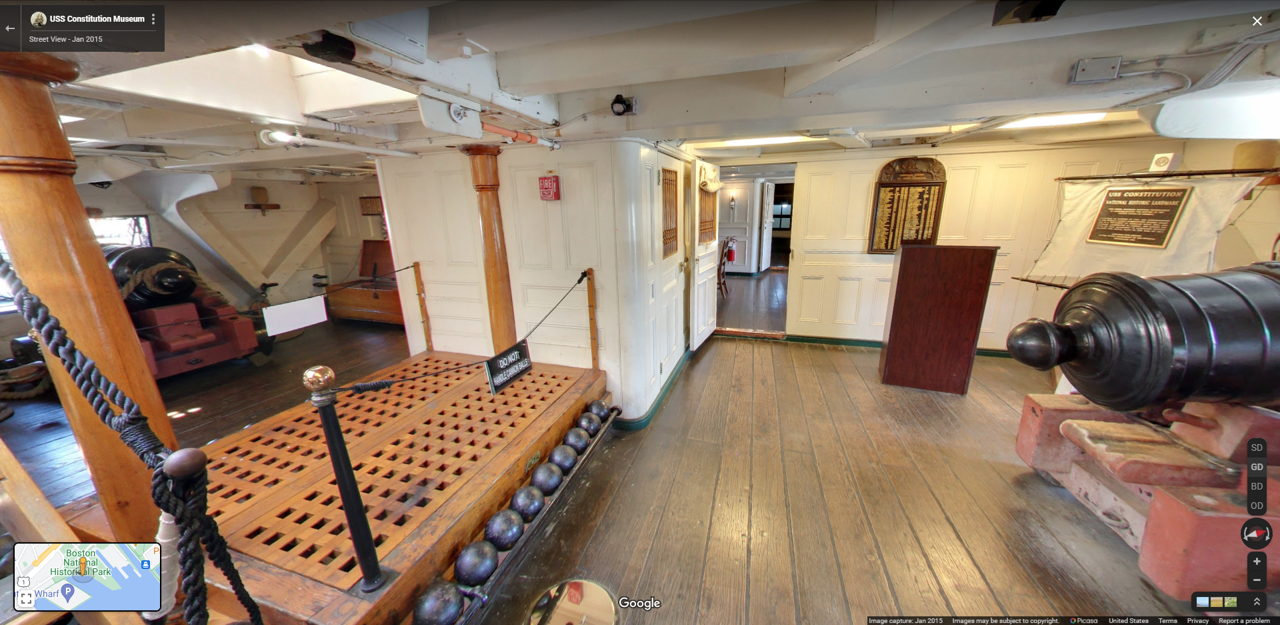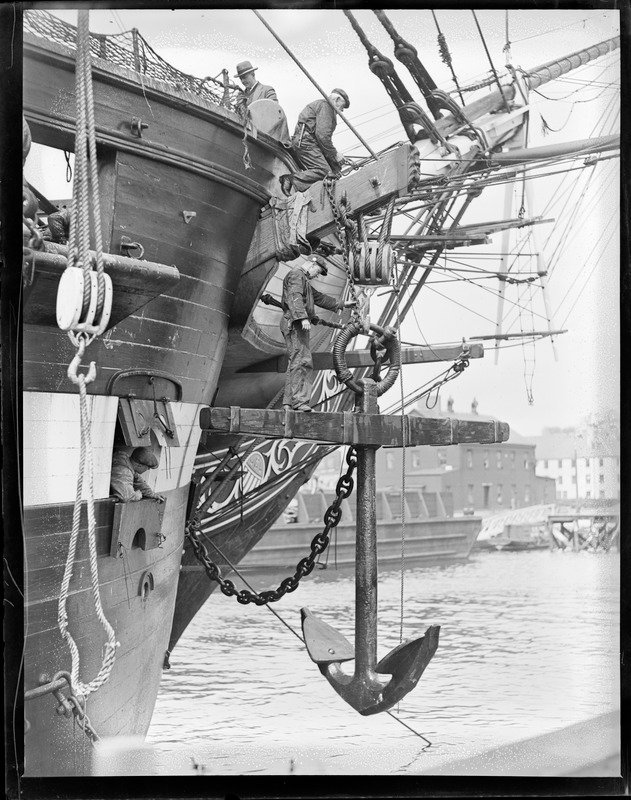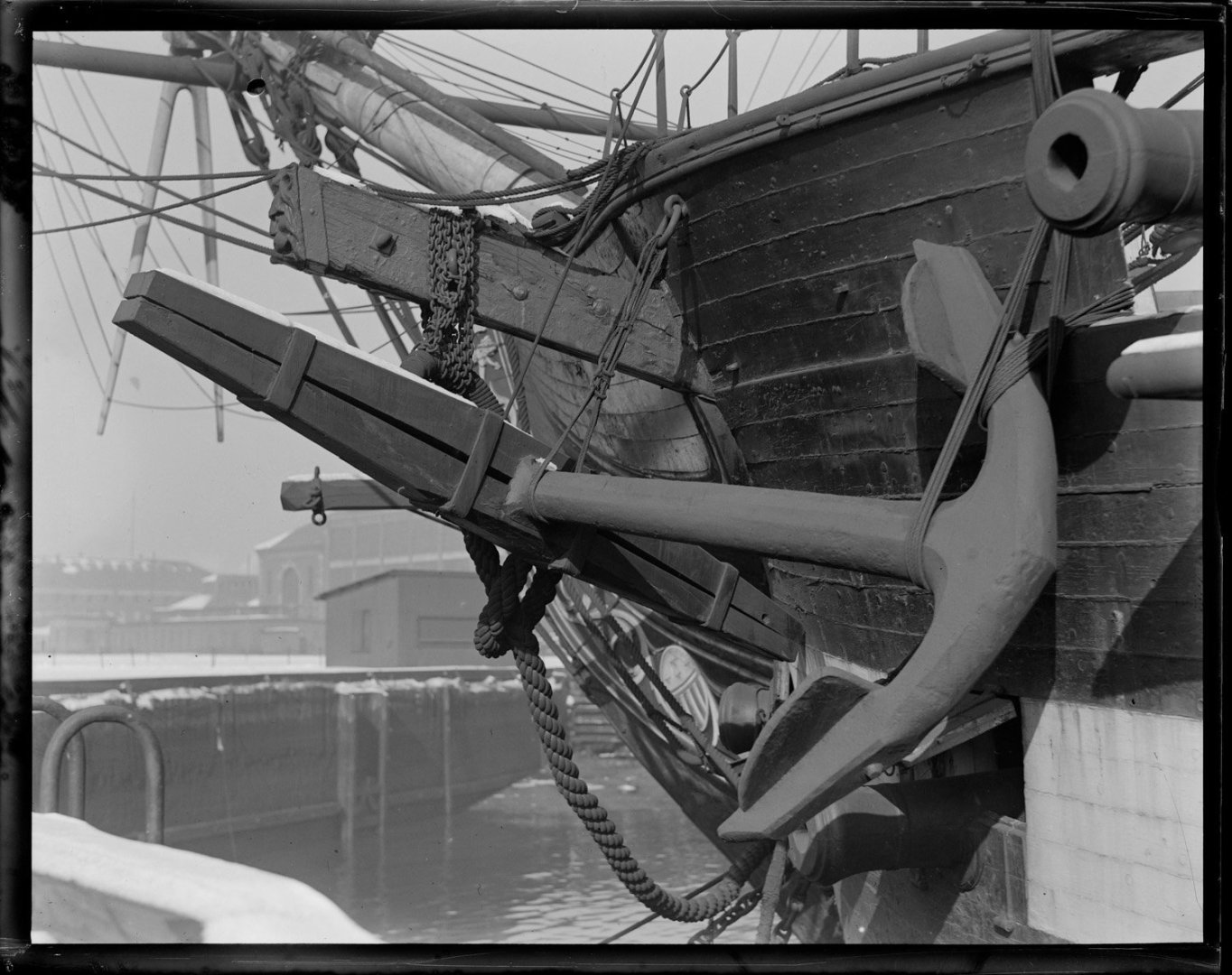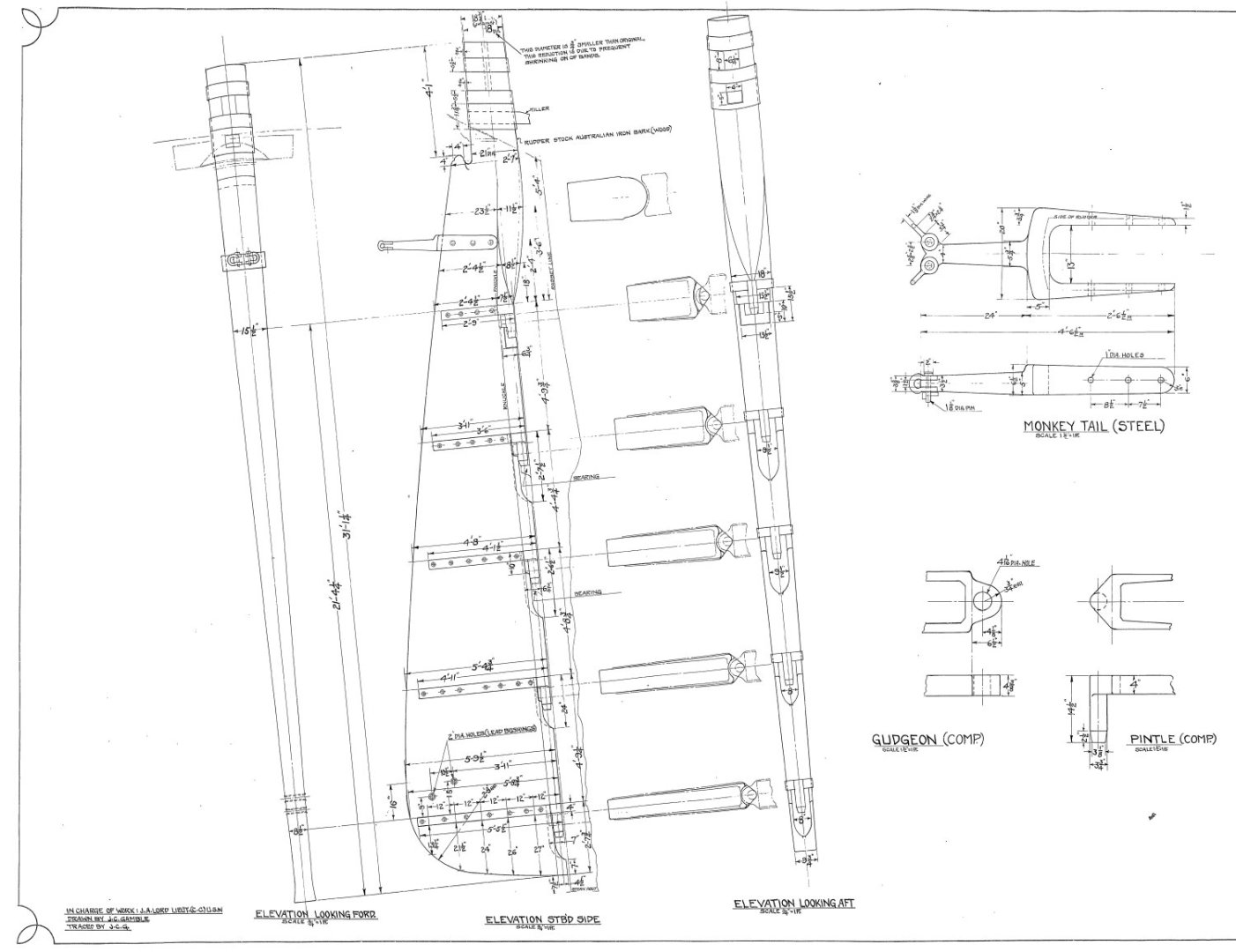-
Posts
2,598 -
Joined
-
Last visited
Content Type
Profiles
Forums
Gallery
Events
Everything posted by JSGerson
-

USS Constitution by mtbediz - 1:76
JSGerson replied to mtbediz's topic in - Build logs for subjects built 1751 - 1800
That chain worked out very nice for you. Jon -
While all of this was going on, I was also busy rigging four more sets of guns to match pace with the gun deck construction. These had to be in position before I could glue into place the dining partition, the Commodore’s pantry, and the spar deck floor beams. The partition doors were then installed in an open configuration leading into the dining area. The last item was installing the mizzen mast supports giving the future mast a 5° rake.
-
When I dry fitted the spar deck floor beam to the partition. I neglected to account for the effect it would have on the partition doors. I had drawn them too tall. Also, I noticed that the printed panels and doors were not to my liking, and the pasting work on the pantry front was not centered properly. So, all the printing and pasting had to be done over, as well as making new shorter doors.
-
Half Column on Commodore’s Pantry The next component was the half column at the center of the forward end of the pantry. This was fabricated just like the column aft of the stove, however one side was flattened using a block sander until only a half column remained. The half column was then glued to the front of the pantry.
-
Construction of the Commodore’s pantry was made from three identical pieces of 1/32” plywood based on the US Navy plans and four vertical glueing surfaces. Using a four-way clamp, the three pantry walls were glued together. Next the two corners were filed to rounded them off. The partition was then dry fitted on the gun deck again for the image below.
-
I cut the doors out of the plywood using an X-acto knife to add some depth in this space. Door handles were made from some bent wire to add some three dimensional detail. Should one be curious enough to look closely with a flashlight, the open doors will give a glimpse to the dining area. The open doors themselves will be added once the pantry is installed.
-
Using card stock, I made a template for the partition. Then, using 1/32” plywood, I fabricated the partition based on the template. Due to the expected confined viewing space and dark lighting inside the finished model, the partition and pantry walls details will not be seen clearly. Like I did for the captain’s cabin’s interior walls previously, I printed the details of the partition walls on paper using PowerPoint and pasted them onto 1/32” plywood.
-
Dining Area Partition and Commodore's Pantry Early in the build, I did not partition the dining room area from the main gun deck area; I was going to leave that open. Since the present configuration of the actual ship has the partition in place, I’ve decided to recreate that on my model. Additionally, I did not construct the Commodore’s Pantry which encompasses the mizzen mast on the gun deck. I thought at the time that I might need that area open to facilitate the seating the mizzen mast. If I sequence assembling the parts correctly, I don’t think that will be a problem. The partition and the pantry will connect to each other.
-
At this point, I’ve installed the main beams above the first two pairs of guns after the bow dummy guns. There are additional supplementary support beams between the main beams which I have not installed because this area will be mostly covered by the spar deck planking. However, as I progress aft, areas of the spar deck will be open to the gun deck for viewing. I haven’t decided whether to install some or none of these supplementary beams because they will substantially obscure the view of the gun deck. This last main beam (as you view the image) is just forward of the main hatch where the whale boat is to be stored on the spare deck. My original intension was to work aft from the bow adding the gun rigging, furniture, support stanchions and beams as I progressed. I have since decided to pause here and start work from the stern forward and pausing to construct the supports for the hatchways as I encounter them.
-

USS Constitution by mtbediz - 1:76
JSGerson replied to mtbediz's topic in - Build logs for subjects built 1751 - 1800
Your chain looks very realistic. I didn't find that type of chain when I went looking a couple of years back. The chain I got is brass, so I will have to blacken it. Jon -

USS Constitution by mtbediz - 1:76
JSGerson replied to mtbediz's topic in - Build logs for subjects built 1751 - 1800
The kit provided a length of approximately 65cm of 10 links/cm plain chain. I purchased, some years ago, 90cm of 4 links/cm cross lug chain. The individual links are about 1 x 3 mm in size. I'm sorry, I didn't record where on the internet I got it from. Jon -
I have always stated that Mr. Hunt's practicums should be used as a GUIDE and not as the bible. The practicums are written as he is building his model, so not only do you see the problems he runs into, but more importantly, WHEN he realizes he has a problem and he has to fix it. If you follow him step by step, you will make the same mistake and have to fix it like he did. He did not go back to edit the practicum to warn the reader of the impending pitfall. You will also find that he does not always complete his model, but talks his way to the finish. That being said, I could not have started, let alone build, my Rattlesnake or presently, the USS Constitution with out his help. Jon
-

USS Constitution by mtbediz - 1:76
JSGerson replied to mtbediz's topic in - Build logs for subjects built 1751 - 1800
GGibson - I have been saving pictures of the USS Constitution from multiple sources ever since I decided to build her. I started my kit in 2017 but my photo library started a year or two earlier and I have not stopped collecting. I do not remember from which source or sources these photos came from (National Archives, or US Navy archives?), but they were taken in 1931. I found that if you try to Google a detail like "USS Constitution Anchor Chain," you may or may not get what you are looking for, but you may get a great reference photo of something else entirely. I retain those images (because I don't know if I could find them again), and categorize them for easy retrieval later. I have thousands of images. Should you (or anyone else) need a USS Constitution image of something, I may have what you are looking for. Jon -

USS Constitution by mtbediz - 1:76
JSGerson replied to mtbediz's topic in - Build logs for subjects built 1751 - 1800
The chain that is provided in the kit, is single link. According to the pictures I've found showing the anchors on the ship, they used chain links with cross studs. At least one anchor used rope. Hope you find this useful. -

USS Constitution by mtbediz - 1:76
JSGerson replied to mtbediz's topic in - Build logs for subjects built 1751 - 1800
As I have said all along; beautiful work. Just be careful that you don't lockout your access to the gun deck before you install the anchor rope(s)/chain(s) and maybe the traveler. Jon -

USS Constitution by mtbediz - 1:76
JSGerson replied to mtbediz's topic in - Build logs for subjects built 1751 - 1800
Beautiful work. At your pace, I'll be following your foot steps very soon. Jon -

USS Constitution by mtbediz - 1:76
JSGerson replied to mtbediz's topic in - Build logs for subjects built 1751 - 1800
It's going to be a shame if you deck over all that lovely bow work. Those supportive beams between the main beams really cut down the view of the gun deck, I've been thinking of making those beams look "broken away" so that the gun deck will be more visible, or maybe leave them off altogether. What are your plans? Jon -
If you look at Khauptfuehrer's Bluejacket build log, he states: "There is a pitfall concerning the rudder installation. The rudder is made from 5/32" stock. If your kit is like mine, you will have gudgeons and pintles whose interior dimension is 1/8". The folks at Bluejacket swear up and down that the dimension is 5/32" but, trust me, it is 1/8". Bending these to suit is difficult and yields less than satisfactory results. Bluejacket also sells gudgeons and pintles with a 1/4" inner measurement. These are easy to adapt and work well. Drops of glue are used to simulate bolt heads I recommend that you buy 1/4" gudgeons and pintles. They will bend easily to suit, and you will be fine." This might be a solution to your problem. Jon
-
Have you thought about the color you're going to paint them. Like ER Rich, mine are copper color. His is painted, mine are made of actual copper. If you look at the ship in dry dock (see my log), the gudgeons and pintles are the same color as the rudder underneath them. Some builders have made them all black. the choice is yours. Jon
-
As you know from reading my blog, I'm not the speediest builder, so take this with a handful of salt. I started my planking in April 2020 and didn't finish until July 2021. Of course, my planking was interrupted by working on the the gun deck and its furniture. So cumulatively, it only took about 9 months to plank my hull and prepare it for copper plating. This is not including the planking around the gun ports which was done earlier. So a month or two to plank your hull, that's nothing.😁 Looking good so far! Remember, it's not a race; take your time and enjoy the journey. Jon
About us
Modelshipworld - Advancing Ship Modeling through Research
SSL Secured
Your security is important for us so this Website is SSL-Secured
NRG Mailing Address
Nautical Research Guild
237 South Lincoln Street
Westmont IL, 60559-1917
Model Ship World ® and the MSW logo are Registered Trademarks, and belong to the Nautical Research Guild (United States Patent and Trademark Office: No. 6,929,264 & No. 6,929,274, registered Dec. 20, 2022)
Helpful Links
About the NRG
If you enjoy building ship models that are historically accurate as well as beautiful, then The Nautical Research Guild (NRG) is just right for you.
The Guild is a non-profit educational organization whose mission is to “Advance Ship Modeling Through Research”. We provide support to our members in their efforts to raise the quality of their model ships.
The Nautical Research Guild has published our world-renowned quarterly magazine, The Nautical Research Journal, since 1955. The pages of the Journal are full of articles by accomplished ship modelers who show you how they create those exquisite details on their models, and by maritime historians who show you the correct details to build. The Journal is available in both print and digital editions. Go to the NRG web site (www.thenrg.org) to download a complimentary digital copy of the Journal. The NRG also publishes plan sets, books and compilations of back issues of the Journal and the former Ships in Scale and Model Ship Builder magazines.





